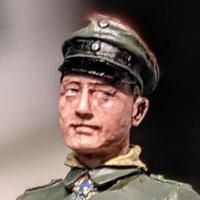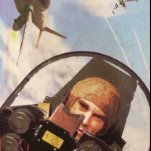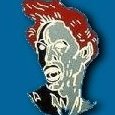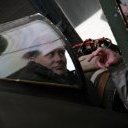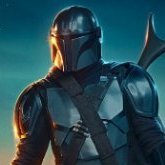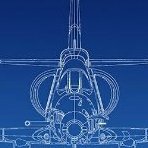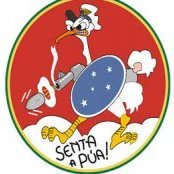-
Posts
35 -
Joined
-
Last visited
Reputation Activity
-
 sillymodeler got a reaction from Lud13 in Ki-61-I Hien “飛燕” in the Papua New Guinea (Hasegawa 1/32)
sillymodeler got a reaction from Lud13 in Ki-61-I Hien “飛燕” in the Papua New Guinea (Hasegawa 1/32)
Hello everyone.
This is my last finished 1/32 Hasegawa, Ki-61-I “飛燕 (Hien)”
I chose this model as I still wanted to explore metal cladding. Hien is a suitable aircraft for this purpose because it was shipped from the factory in bare metal and then various camouflages were applied by units. I used the usual kitchen aluminum foil and water-soluble glue for the metal cladding.
The hand-painted random camouflage applied to Hien is another attractive point for modelers. So, I hand-painted a crooked camouflage pattern on the fuselage and wings with an airbrush like a mechanic of the time. It was the most enjoyable thing in this build. One of the advantages of metal cladding is that you can redo the camouflage paint as many times as you like.
Unlike other Japanese airplanes, Hien was equipped with a liquid-cooled DB601 engine produced under license. However, it suffered from low reliability and low mission-capable rates due to insufficient craft quality and frontline supply, and the inexperience of mechanics on liquid-cooled engines. However, as long as it was up and running, it performed as well or better than its elder brother Bf109E.
I adopted a paint scheme inspired by the 68th squadron that fought in Papua New Guinea. The squadron was one of the first to receive the newly developed Hien. Papua New Guinea was far from its homeland and probably one of the harshest battlefields in WW2. Many died not only from battle but also from starvation and disease as supply lines were destroyed. It is said during the war: “Java is paradise, Burma is hell, and you can't return home from New Guinea even if you die”. Actually, most of the members of the 68th squadron, as well as many other soldiers, are still lying there.
It’s basically OOB build. I just used metal gum barrels and pitot tube. The squadron marking is a combination of hand-painting and some extra decals. I also slightly modified Hasegawa’s lovely kit figure to one that resembles tropical pilot uniforms. (One more thing, I would like you to assume that my model is a reproduction of an aircraft whose tailwheel was lost in an accident on the battlefield. The tailwheel is still lying somewhere in my room.)
I hope you all enjoy the model. Sorry for my plastic cup as usual!
-
 sillymodeler got a reaction from Martinnfb in Hawker Hurricane prototype K5083 (Pacific Coast Models modified 1/32)
sillymodeler got a reaction from Martinnfb in Hawker Hurricane prototype K5083 (Pacific Coast Models modified 1/32)
Thank you for your comments!
I am honored that my build is published as an article.
-
 sillymodeler got a reaction from Martinnfb in Hawker Hurricane prototype K5083 (Pacific Coast Models modified 1/32)
sillymodeler got a reaction from Martinnfb in Hawker Hurricane prototype K5083 (Pacific Coast Models modified 1/32)
Of course! Thank you for the honored offer!
-
 sillymodeler got a reaction from Martinnfb in Hawker Hurricane prototype K5083 (Pacific Coast Models modified 1/32)
sillymodeler got a reaction from Martinnfb in Hawker Hurricane prototype K5083 (Pacific Coast Models modified 1/32)
@mozart
Thank you. Yeah, I noticed the kit canopy is a bit different from the prototype. and I also found the shape of the rudder is different after I painted my model. Haha. PCM kits are hard to find, but we need to build them before Kotare hopefully releases Mk.I.
I have fixed some of the photos in my post that were not showing. -
 sillymodeler got a reaction from Fencer-1 in Hawker Hurricane prototype K5083 (Pacific Coast Models modified 1/32)
sillymodeler got a reaction from Fencer-1 in Hawker Hurricane prototype K5083 (Pacific Coast Models modified 1/32)
Hi everyone
I recently completed building my Hawker Hurricane prototype K5083.
This is basically a Pacific Coast Models Hawker Hurricane Mk.I (Early version). I changed its engine cowling panel lines and exhaust pipes to make it look like a prototype.
Hawker Hurricane is characterized by its mixed fabric and metal construction, which is most evident in the coloring of the prototype model. To show the difference between metal and fabric, aluminum foil was applied to the metal part, and silver dope color was applied to the fabric part. The aircraft numbers were airbrushed with handmade stencils and then fine-tuned by hand-painting. The prototype was modified through the process of its development. I specifically built the version of the plane that the RAF finally evaluated at Martlesham Heath airfield because this version most closely looks like PCM Mk.I Early kit. However, I may be wrong as I do not have sufficient reference documentation.
The Hurricane is often hidden in the shadow of the Spitfire, but it is a masterpiece that served irreplaceably as the RAF's warhorse. I built this model to honor my favorite unsung hero.
I hope you all like it. (I like to build model airplanes in flight status, but I should have something better than a plastic cup for display.)
-
 sillymodeler got a reaction from Mark_C in Ki-61-I Hien “飛燕” in the Papua New Guinea (Hasegawa 1/32)
sillymodeler got a reaction from Mark_C in Ki-61-I Hien “飛燕” in the Papua New Guinea (Hasegawa 1/32)
Hello everyone.
This is my last finished 1/32 Hasegawa, Ki-61-I “飛燕 (Hien)”
I chose this model as I still wanted to explore metal cladding. Hien is a suitable aircraft for this purpose because it was shipped from the factory in bare metal and then various camouflages were applied by units. I used the usual kitchen aluminum foil and water-soluble glue for the metal cladding.
The hand-painted random camouflage applied to Hien is another attractive point for modelers. So, I hand-painted a crooked camouflage pattern on the fuselage and wings with an airbrush like a mechanic of the time. It was the most enjoyable thing in this build. One of the advantages of metal cladding is that you can redo the camouflage paint as many times as you like.
Unlike other Japanese airplanes, Hien was equipped with a liquid-cooled DB601 engine produced under license. However, it suffered from low reliability and low mission-capable rates due to insufficient craft quality and frontline supply, and the inexperience of mechanics on liquid-cooled engines. However, as long as it was up and running, it performed as well or better than its elder brother Bf109E.
I adopted a paint scheme inspired by the 68th squadron that fought in Papua New Guinea. The squadron was one of the first to receive the newly developed Hien. Papua New Guinea was far from its homeland and probably one of the harshest battlefields in WW2. Many died not only from battle but also from starvation and disease as supply lines were destroyed. It is said during the war: “Java is paradise, Burma is hell, and you can't return home from New Guinea even if you die”. Actually, most of the members of the 68th squadron, as well as many other soldiers, are still lying there.
It’s basically OOB build. I just used metal gum barrels and pitot tube. The squadron marking is a combination of hand-painting and some extra decals. I also slightly modified Hasegawa’s lovely kit figure to one that resembles tropical pilot uniforms. (One more thing, I would like you to assume that my model is a reproduction of an aircraft whose tailwheel was lost in an accident on the battlefield. The tailwheel is still lying somewhere in my room.)
I hope you all enjoy the model. Sorry for my plastic cup as usual!
-
 sillymodeler got a reaction from Alain Gadbois in Ki-61-I Hien “飛燕” in the Papua New Guinea (Hasegawa 1/32)
sillymodeler got a reaction from Alain Gadbois in Ki-61-I Hien “飛燕” in the Papua New Guinea (Hasegawa 1/32)
Hello everyone.
This is my last finished 1/32 Hasegawa, Ki-61-I “飛燕 (Hien)”
I chose this model as I still wanted to explore metal cladding. Hien is a suitable aircraft for this purpose because it was shipped from the factory in bare metal and then various camouflages were applied by units. I used the usual kitchen aluminum foil and water-soluble glue for the metal cladding.
The hand-painted random camouflage applied to Hien is another attractive point for modelers. So, I hand-painted a crooked camouflage pattern on the fuselage and wings with an airbrush like a mechanic of the time. It was the most enjoyable thing in this build. One of the advantages of metal cladding is that you can redo the camouflage paint as many times as you like.
Unlike other Japanese airplanes, Hien was equipped with a liquid-cooled DB601 engine produced under license. However, it suffered from low reliability and low mission-capable rates due to insufficient craft quality and frontline supply, and the inexperience of mechanics on liquid-cooled engines. However, as long as it was up and running, it performed as well or better than its elder brother Bf109E.
I adopted a paint scheme inspired by the 68th squadron that fought in Papua New Guinea. The squadron was one of the first to receive the newly developed Hien. Papua New Guinea was far from its homeland and probably one of the harshest battlefields in WW2. Many died not only from battle but also from starvation and disease as supply lines were destroyed. It is said during the war: “Java is paradise, Burma is hell, and you can't return home from New Guinea even if you die”. Actually, most of the members of the 68th squadron, as well as many other soldiers, are still lying there.
It’s basically OOB build. I just used metal gum barrels and pitot tube. The squadron marking is a combination of hand-painting and some extra decals. I also slightly modified Hasegawa’s lovely kit figure to one that resembles tropical pilot uniforms. (One more thing, I would like you to assume that my model is a reproduction of an aircraft whose tailwheel was lost in an accident on the battlefield. The tailwheel is still lying somewhere in my room.)
I hope you all enjoy the model. Sorry for my plastic cup as usual!
-
 sillymodeler got a reaction from Biggles87 in Ki-61-I Hien “飛燕” in the Papua New Guinea (Hasegawa 1/32)
sillymodeler got a reaction from Biggles87 in Ki-61-I Hien “飛燕” in the Papua New Guinea (Hasegawa 1/32)
Hello everyone.
This is my last finished 1/32 Hasegawa, Ki-61-I “飛燕 (Hien)”
I chose this model as I still wanted to explore metal cladding. Hien is a suitable aircraft for this purpose because it was shipped from the factory in bare metal and then various camouflages were applied by units. I used the usual kitchen aluminum foil and water-soluble glue for the metal cladding.
The hand-painted random camouflage applied to Hien is another attractive point for modelers. So, I hand-painted a crooked camouflage pattern on the fuselage and wings with an airbrush like a mechanic of the time. It was the most enjoyable thing in this build. One of the advantages of metal cladding is that you can redo the camouflage paint as many times as you like.
Unlike other Japanese airplanes, Hien was equipped with a liquid-cooled DB601 engine produced under license. However, it suffered from low reliability and low mission-capable rates due to insufficient craft quality and frontline supply, and the inexperience of mechanics on liquid-cooled engines. However, as long as it was up and running, it performed as well or better than its elder brother Bf109E.
I adopted a paint scheme inspired by the 68th squadron that fought in Papua New Guinea. The squadron was one of the first to receive the newly developed Hien. Papua New Guinea was far from its homeland and probably one of the harshest battlefields in WW2. Many died not only from battle but also from starvation and disease as supply lines were destroyed. It is said during the war: “Java is paradise, Burma is hell, and you can't return home from New Guinea even if you die”. Actually, most of the members of the 68th squadron, as well as many other soldiers, are still lying there.
It’s basically OOB build. I just used metal gum barrels and pitot tube. The squadron marking is a combination of hand-painting and some extra decals. I also slightly modified Hasegawa’s lovely kit figure to one that resembles tropical pilot uniforms. (One more thing, I would like you to assume that my model is a reproduction of an aircraft whose tailwheel was lost in an accident on the battlefield. The tailwheel is still lying somewhere in my room.)
I hope you all enjoy the model. Sorry for my plastic cup as usual!
-
 sillymodeler got a reaction from Paulpk in Ki-61-I Hien “飛燕” in the Papua New Guinea (Hasegawa 1/32)
sillymodeler got a reaction from Paulpk in Ki-61-I Hien “飛燕” in the Papua New Guinea (Hasegawa 1/32)
Hello everyone.
This is my last finished 1/32 Hasegawa, Ki-61-I “飛燕 (Hien)”
I chose this model as I still wanted to explore metal cladding. Hien is a suitable aircraft for this purpose because it was shipped from the factory in bare metal and then various camouflages were applied by units. I used the usual kitchen aluminum foil and water-soluble glue for the metal cladding.
The hand-painted random camouflage applied to Hien is another attractive point for modelers. So, I hand-painted a crooked camouflage pattern on the fuselage and wings with an airbrush like a mechanic of the time. It was the most enjoyable thing in this build. One of the advantages of metal cladding is that you can redo the camouflage paint as many times as you like.
Unlike other Japanese airplanes, Hien was equipped with a liquid-cooled DB601 engine produced under license. However, it suffered from low reliability and low mission-capable rates due to insufficient craft quality and frontline supply, and the inexperience of mechanics on liquid-cooled engines. However, as long as it was up and running, it performed as well or better than its elder brother Bf109E.
I adopted a paint scheme inspired by the 68th squadron that fought in Papua New Guinea. The squadron was one of the first to receive the newly developed Hien. Papua New Guinea was far from its homeland and probably one of the harshest battlefields in WW2. Many died not only from battle but also from starvation and disease as supply lines were destroyed. It is said during the war: “Java is paradise, Burma is hell, and you can't return home from New Guinea even if you die”. Actually, most of the members of the 68th squadron, as well as many other soldiers, are still lying there.
It’s basically OOB build. I just used metal gum barrels and pitot tube. The squadron marking is a combination of hand-painting and some extra decals. I also slightly modified Hasegawa’s lovely kit figure to one that resembles tropical pilot uniforms. (One more thing, I would like you to assume that my model is a reproduction of an aircraft whose tailwheel was lost in an accident on the battlefield. The tailwheel is still lying somewhere in my room.)
I hope you all enjoy the model. Sorry for my plastic cup as usual!
-
 sillymodeler got a reaction from Furie in Hawker Hurricane prototype K5083 (Pacific Coast Models modified 1/32)
sillymodeler got a reaction from Furie in Hawker Hurricane prototype K5083 (Pacific Coast Models modified 1/32)
Hi everyone
I recently completed building my Hawker Hurricane prototype K5083.
This is basically a Pacific Coast Models Hawker Hurricane Mk.I (Early version). I changed its engine cowling panel lines and exhaust pipes to make it look like a prototype.
Hawker Hurricane is characterized by its mixed fabric and metal construction, which is most evident in the coloring of the prototype model. To show the difference between metal and fabric, aluminum foil was applied to the metal part, and silver dope color was applied to the fabric part. The aircraft numbers were airbrushed with handmade stencils and then fine-tuned by hand-painting. The prototype was modified through the process of its development. I specifically built the version of the plane that the RAF finally evaluated at Martlesham Heath airfield because this version most closely looks like PCM Mk.I Early kit. However, I may be wrong as I do not have sufficient reference documentation.
The Hurricane is often hidden in the shadow of the Spitfire, but it is a masterpiece that served irreplaceably as the RAF's warhorse. I built this model to honor my favorite unsung hero.
I hope you all like it. (I like to build model airplanes in flight status, but I should have something better than a plastic cup for display.)
-
 sillymodeler got a reaction from Panzerwomble in Hawker Hurricane prototype K5083 (Pacific Coast Models modified 1/32)
sillymodeler got a reaction from Panzerwomble in Hawker Hurricane prototype K5083 (Pacific Coast Models modified 1/32)
Hi everyone
I recently completed building my Hawker Hurricane prototype K5083.
This is basically a Pacific Coast Models Hawker Hurricane Mk.I (Early version). I changed its engine cowling panel lines and exhaust pipes to make it look like a prototype.
Hawker Hurricane is characterized by its mixed fabric and metal construction, which is most evident in the coloring of the prototype model. To show the difference between metal and fabric, aluminum foil was applied to the metal part, and silver dope color was applied to the fabric part. The aircraft numbers were airbrushed with handmade stencils and then fine-tuned by hand-painting. The prototype was modified through the process of its development. I specifically built the version of the plane that the RAF finally evaluated at Martlesham Heath airfield because this version most closely looks like PCM Mk.I Early kit. However, I may be wrong as I do not have sufficient reference documentation.
The Hurricane is often hidden in the shadow of the Spitfire, but it is a masterpiece that served irreplaceably as the RAF's warhorse. I built this model to honor my favorite unsung hero.
I hope you all like it. (I like to build model airplanes in flight status, but I should have something better than a plastic cup for display.)
-
 sillymodeler got a reaction from Fanes in Hawker Hurricane prototype K5083 (Pacific Coast Models modified 1/32)
sillymodeler got a reaction from Fanes in Hawker Hurricane prototype K5083 (Pacific Coast Models modified 1/32)
Hi everyone
I recently completed building my Hawker Hurricane prototype K5083.
This is basically a Pacific Coast Models Hawker Hurricane Mk.I (Early version). I changed its engine cowling panel lines and exhaust pipes to make it look like a prototype.
Hawker Hurricane is characterized by its mixed fabric and metal construction, which is most evident in the coloring of the prototype model. To show the difference between metal and fabric, aluminum foil was applied to the metal part, and silver dope color was applied to the fabric part. The aircraft numbers were airbrushed with handmade stencils and then fine-tuned by hand-painting. The prototype was modified through the process of its development. I specifically built the version of the plane that the RAF finally evaluated at Martlesham Heath airfield because this version most closely looks like PCM Mk.I Early kit. However, I may be wrong as I do not have sufficient reference documentation.
The Hurricane is often hidden in the shadow of the Spitfire, but it is a masterpiece that served irreplaceably as the RAF's warhorse. I built this model to honor my favorite unsung hero.
I hope you all like it. (I like to build model airplanes in flight status, but I should have something better than a plastic cup for display.)
-
 sillymodeler reacted to Plm in HPH Fw 189 Uhu
sillymodeler reacted to Plm in HPH Fw 189 Uhu
Hello,
Here is my last build, a very long one with a lot of sanding, test fitting and sometimes the help of boiling water to straighten parts.
-
 sillymodeler reacted to Gazzas in Galland, His E4... and Some Friends.
sillymodeler reacted to Gazzas in Galland, His E4... and Some Friends.
Hi Everyone! These are the final photos taken of my recent completion from the Aces High group build hosted by LSP. The kit itself was sold to me by a fellow LSP'er and I'm glad to get it done. Yet these aren't the pictures I wanted. These are pictures saved from the recycle bin. I wanted pics with perfect lighting taken perfectly. Alas, the perfect lighting didn't present itself, and the model itself suffered a gravity related catastrophe and awaits repair. There are a lot of pics. I hope you like them.
More to come...
-
 sillymodeler reacted to Miloslav1956 in P-51B Capt. Burton N. Rodier Jr. 26FS/51FG
sillymodeler reacted to Miloslav1956 in P-51B Capt. Burton N. Rodier Jr. 26FS/51FG
1/32 Trumpeter model, Aires cockpit, wheelbay, weapons, Eduard wheels & propeller, Lifelike decals, Mask homemade, All colors MRP
-
 sillymodeler got a reaction from Greg W in Fokker E.IV, Oswald Boelcke (Wingnut Wings 1/32)
sillymodeler got a reaction from Greg W in Fokker E.IV, Oswald Boelcke (Wingnut Wings 1/32)
Hi everyone
This build is a Fokker E.IV prototype with the father of German fighter tactics and the mentor of Red Baron, Oswald Boelcke.
His plane has a special personal emblem combining O and B on the center of the engine cowling. Although not explicitly indicated in the kit, this kit is designed to reproduce Boelcke’s Fokker E.IV. The kit has his personal emblem, actually.
The Fokker E.IV was similar in appearance to the E.III and early Eindeckers but had a huge double-row 14-cylinder engine, which was unusual for WWI aircraft. It did not seem to be maneuverable due to the reaction torque generated by the heavy rotary engine. The rotary engines of the time leaked a lot of oil, so the underside of the fuselage was heavily weathered in this build.
The figure is made by my favorite figure maker, Model Cellar, and they produce a lot of WWI pilots.
I hope you guys enjoy it.
-
 sillymodeler got a reaction from TAG in Hawker Hurricane prototype K5083 (Pacific Coast Models modified 1/32)
sillymodeler got a reaction from TAG in Hawker Hurricane prototype K5083 (Pacific Coast Models modified 1/32)
Hi everyone
I recently completed building my Hawker Hurricane prototype K5083.
This is basically a Pacific Coast Models Hawker Hurricane Mk.I (Early version). I changed its engine cowling panel lines and exhaust pipes to make it look like a prototype.
Hawker Hurricane is characterized by its mixed fabric and metal construction, which is most evident in the coloring of the prototype model. To show the difference between metal and fabric, aluminum foil was applied to the metal part, and silver dope color was applied to the fabric part. The aircraft numbers were airbrushed with handmade stencils and then fine-tuned by hand-painting. The prototype was modified through the process of its development. I specifically built the version of the plane that the RAF finally evaluated at Martlesham Heath airfield because this version most closely looks like PCM Mk.I Early kit. However, I may be wrong as I do not have sufficient reference documentation.
The Hurricane is often hidden in the shadow of the Spitfire, but it is a masterpiece that served irreplaceably as the RAF's warhorse. I built this model to honor my favorite unsung hero.
I hope you all like it. (I like to build model airplanes in flight status, but I should have something better than a plastic cup for display.)
-
 sillymodeler got a reaction from chaos07 in Fokker E.IV, Oswald Boelcke (Wingnut Wings 1/32)
sillymodeler got a reaction from chaos07 in Fokker E.IV, Oswald Boelcke (Wingnut Wings 1/32)
Hi everyone
This build is a Fokker E.IV prototype with the father of German fighter tactics and the mentor of Red Baron, Oswald Boelcke.
His plane has a special personal emblem combining O and B on the center of the engine cowling. Although not explicitly indicated in the kit, this kit is designed to reproduce Boelcke’s Fokker E.IV. The kit has his personal emblem, actually.
The Fokker E.IV was similar in appearance to the E.III and early Eindeckers but had a huge double-row 14-cylinder engine, which was unusual for WWI aircraft. It did not seem to be maneuverable due to the reaction torque generated by the heavy rotary engine. The rotary engines of the time leaked a lot of oil, so the underside of the fuselage was heavily weathered in this build.
The figure is made by my favorite figure maker, Model Cellar, and they produce a lot of WWI pilots.
I hope you guys enjoy it.
-
 sillymodeler got a reaction from Martinnfb in Hawker Hurricane prototype K5083 (Pacific Coast Models modified 1/32)
sillymodeler got a reaction from Martinnfb in Hawker Hurricane prototype K5083 (Pacific Coast Models modified 1/32)
Hi everyone
I recently completed building my Hawker Hurricane prototype K5083.
This is basically a Pacific Coast Models Hawker Hurricane Mk.I (Early version). I changed its engine cowling panel lines and exhaust pipes to make it look like a prototype.
Hawker Hurricane is characterized by its mixed fabric and metal construction, which is most evident in the coloring of the prototype model. To show the difference between metal and fabric, aluminum foil was applied to the metal part, and silver dope color was applied to the fabric part. The aircraft numbers were airbrushed with handmade stencils and then fine-tuned by hand-painting. The prototype was modified through the process of its development. I specifically built the version of the plane that the RAF finally evaluated at Martlesham Heath airfield because this version most closely looks like PCM Mk.I Early kit. However, I may be wrong as I do not have sufficient reference documentation.
The Hurricane is often hidden in the shadow of the Spitfire, but it is a masterpiece that served irreplaceably as the RAF's warhorse. I built this model to honor my favorite unsung hero.
I hope you all like it. (I like to build model airplanes in flight status, but I should have something better than a plastic cup for display.)
-
 sillymodeler got a reaction from Dpgsbody55 in Fokker E.IV, Oswald Boelcke (Wingnut Wings 1/32)
sillymodeler got a reaction from Dpgsbody55 in Fokker E.IV, Oswald Boelcke (Wingnut Wings 1/32)
Hi everyone
This build is a Fokker E.IV prototype with the father of German fighter tactics and the mentor of Red Baron, Oswald Boelcke.
His plane has a special personal emblem combining O and B on the center of the engine cowling. Although not explicitly indicated in the kit, this kit is designed to reproduce Boelcke’s Fokker E.IV. The kit has his personal emblem, actually.
The Fokker E.IV was similar in appearance to the E.III and early Eindeckers but had a huge double-row 14-cylinder engine, which was unusual for WWI aircraft. It did not seem to be maneuverable due to the reaction torque generated by the heavy rotary engine. The rotary engines of the time leaked a lot of oil, so the underside of the fuselage was heavily weathered in this build.
The figure is made by my favorite figure maker, Model Cellar, and they produce a lot of WWI pilots.
I hope you guys enjoy it.
-
 sillymodeler reacted to Tolga ULGUR in 1/32 GWH P-40B TuAF Tomahawk
sillymodeler reacted to Tolga ULGUR in 1/32 GWH P-40B TuAF Tomahawk
This is my recently finished 1/32 Great Wall Hobby's P-40B with TuAF markings .
These Tomahawks were Ex-RAF Tomahawks from Mediterannean stocks.
They were re-painted in Turkey by using RAF fighter paints.
Cockpit modified by using Eduard instrument panels and RAF seatbelts. I found the RAF gunsight from an old Hasegawa Spitfire in my spare box and used it.
Main wheels are from Barracudacast
Paints are Gunze Sangyo acrylics.
National insignias are painted by masking
Star and Crescent on the rudder is from Turquoise decal
"White 3" decal is from Customhobbydecals.
Happy modelling
-
 sillymodeler got a reaction from olgerd83 in Fokker E.IV, Oswald Boelcke (Wingnut Wings 1/32)
sillymodeler got a reaction from olgerd83 in Fokker E.IV, Oswald Boelcke (Wingnut Wings 1/32)
Hi everyone
This build is a Fokker E.IV prototype with the father of German fighter tactics and the mentor of Red Baron, Oswald Boelcke.
His plane has a special personal emblem combining O and B on the center of the engine cowling. Although not explicitly indicated in the kit, this kit is designed to reproduce Boelcke’s Fokker E.IV. The kit has his personal emblem, actually.
The Fokker E.IV was similar in appearance to the E.III and early Eindeckers but had a huge double-row 14-cylinder engine, which was unusual for WWI aircraft. It did not seem to be maneuverable due to the reaction torque generated by the heavy rotary engine. The rotary engines of the time leaked a lot of oil, so the underside of the fuselage was heavily weathered in this build.
The figure is made by my favorite figure maker, Model Cellar, and they produce a lot of WWI pilots.
I hope you guys enjoy it.
-
 sillymodeler got a reaction from Stefano in Fokker E.IV, Oswald Boelcke (Wingnut Wings 1/32)
sillymodeler got a reaction from Stefano in Fokker E.IV, Oswald Boelcke (Wingnut Wings 1/32)
Hi everyone
This build is a Fokker E.IV prototype with the father of German fighter tactics and the mentor of Red Baron, Oswald Boelcke.
His plane has a special personal emblem combining O and B on the center of the engine cowling. Although not explicitly indicated in the kit, this kit is designed to reproduce Boelcke’s Fokker E.IV. The kit has his personal emblem, actually.
The Fokker E.IV was similar in appearance to the E.III and early Eindeckers but had a huge double-row 14-cylinder engine, which was unusual for WWI aircraft. It did not seem to be maneuverable due to the reaction torque generated by the heavy rotary engine. The rotary engines of the time leaked a lot of oil, so the underside of the fuselage was heavily weathered in this build.
The figure is made by my favorite figure maker, Model Cellar, and they produce a lot of WWI pilots.
I hope you guys enjoy it.
-
 sillymodeler got a reaction from Yamamoto in Fokker E.IV, Oswald Boelcke (Wingnut Wings 1/32)
sillymodeler got a reaction from Yamamoto in Fokker E.IV, Oswald Boelcke (Wingnut Wings 1/32)
Hi everyone
This build is a Fokker E.IV prototype with the father of German fighter tactics and the mentor of Red Baron, Oswald Boelcke.
His plane has a special personal emblem combining O and B on the center of the engine cowling. Although not explicitly indicated in the kit, this kit is designed to reproduce Boelcke’s Fokker E.IV. The kit has his personal emblem, actually.
The Fokker E.IV was similar in appearance to the E.III and early Eindeckers but had a huge double-row 14-cylinder engine, which was unusual for WWI aircraft. It did not seem to be maneuverable due to the reaction torque generated by the heavy rotary engine. The rotary engines of the time leaked a lot of oil, so the underside of the fuselage was heavily weathered in this build.
The figure is made by my favorite figure maker, Model Cellar, and they produce a lot of WWI pilots.
I hope you guys enjoy it.
-
 sillymodeler got a reaction from BiggTim in Fokker E.IV, Oswald Boelcke (Wingnut Wings 1/32)
sillymodeler got a reaction from BiggTim in Fokker E.IV, Oswald Boelcke (Wingnut Wings 1/32)
Hi everyone
This build is a Fokker E.IV prototype with the father of German fighter tactics and the mentor of Red Baron, Oswald Boelcke.
His plane has a special personal emblem combining O and B on the center of the engine cowling. Although not explicitly indicated in the kit, this kit is designed to reproduce Boelcke’s Fokker E.IV. The kit has his personal emblem, actually.
The Fokker E.IV was similar in appearance to the E.III and early Eindeckers but had a huge double-row 14-cylinder engine, which was unusual for WWI aircraft. It did not seem to be maneuverable due to the reaction torque generated by the heavy rotary engine. The rotary engines of the time leaked a lot of oil, so the underside of the fuselage was heavily weathered in this build.
The figure is made by my favorite figure maker, Model Cellar, and they produce a lot of WWI pilots.
I hope you guys enjoy it.


